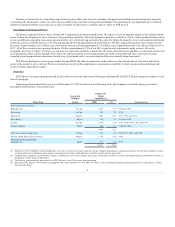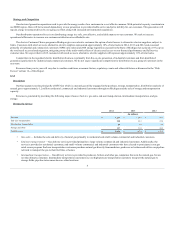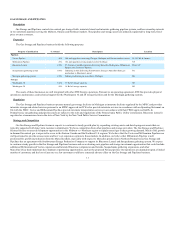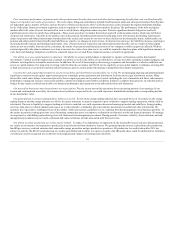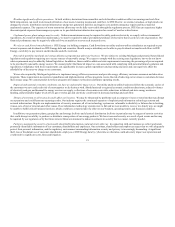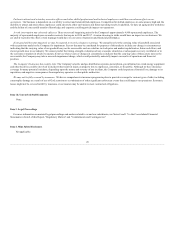DTE Energy 2014 Annual Report Download - page 17
Download and view the complete annual report
Please find page 17 of the 2014 DTE Energy annual report below. You can navigate through the pages in the report by either clicking on the pages listed below, or by using the keyword search tool below to find specific information within the annual report.
We are subject to extensive environmental regulation. We expect to continue recovering environmental costs related to utility operations through rates
charged to our customers. The following table summarizes our estimated significant future environmental expenditures based upon current regulations.
Actual costs to comply could vary substantially. Additional costs may result as the effects of various substances on the environment are studied and
governmental regulations are developed and implemented.
Air $ 150
$ —
$ —
$ 150
Water 70
—
15
85
Contaminated and other sites 180
25
—
205
Estimated total future expenditures through 2019 $ 400
$ 25
$ 15
$ 440
Estimated 2015 expenditures $ 100
$ 5
$ 10
$ 115
Estimated 2016 expenditures $ 40
$ 5
$ 5
$ 50
Air - DTE Electric is subject to the EPA ozone and fine particulate transport and acid rain regulations that limit power plant emissions of sulfur dioxide
and nitrogen oxides. Since 2005, the EPA and the State of Michigan have issued additional emission reduction regulations relating to ozone, fine particulate,
regional haze, mercury and other air pollution. These rules have led to additional emission controls on fossil-fueled power plants to reduce nitrogen oxide
and sulfur dioxide, with further emission controls planned for reductions of mercury and other emissions. These rulemakings could require additional
controls for sulfur dioxide, nitrogen oxides and other hazardous air pollutants over the next few years.
The EPA is implementing regulatory actions under the Clean Air Act to address emissions of greenhouse gases (GHGs) from the utility sector and other
sectors of the economy. Among these actions, the EPA is proposing performance standards for emissions of carbon dioxide from new and existing electric
generating units (EGUs). The EPA plans to issue a final standard for both new and existing sources by July 2015. The carbon standards for new sources are
not expected to have a material impact on the Company, since the Company has no plans to build new coal-fired generation. It is not possible to determine
the potential impact of future regulations on existing sources at this time. Pending or future legislation or other regulatory actions could have a material
impact on our operations and financial position and the rates we charge our customers. Impacts include expenditures for environmental equipment beyond
what is currently planned, financing costs related to additional capital expenditures, the purchase of emission credits from market sources, higher costs of
purchased power, and the retirement of facilities where control equipment is not economical. We would seek to recover these incremental costs through
increased rates charged to our utility customers as authorized by the MPSC.
Water - The EPA finalized regulations on cooling water intake in August 2014. DTE Electric is conducting studies to determine the best technology for
reducing the environmental impacts of the cooling water intake structures at each of its facilities. DTE Electric may be required to install technologies to
reduce the impacts of the cooling water intakes. The EPA has also issued proposed steam electric effluent guidelines. These rules are expected to require
additional wastewater discharge controls.
Contaminated and Other Sites - Prior to the construction of major interstate natural gas pipelines, gas for heating and other uses was manufactured
locally from processes involving coal, coke or oil. The facilities, which produced gas, have been designated as MGP sites. Gas segment owns, or previously
owned, fifteen such former MGP sites. DTE Electric owns, or previously owned, three former MGP sites. The Company anticipates the cost amortization
methodology approved by the MPSC for DTE Gas, which allows DTE Gas to amortize the MGP costs over a ten-year period beginning with the year
subsequent to the year the MGP costs were incurred, will prevent environmental costs from having a material adverse effect on the Company's operations.
We are also in the process of cleaning up other sites where contamination is present as a result of historical and ongoing utility operations. These other
sites include an engineered ash storage facility, electrical distribution substations, gas pipelines, electric generating power plants, and underground and
aboveground storage tank locations. Cleanup activities associated with these sites will be conducted over the next several years. Any significant change in
assumptions, such as remediation techniques, nature and extent of contamination and regulatory requirements, could impact the estimate of remedial action
costs for these sites and affect the Company's financial position and cash flows and the rates we charge our customers.
15



